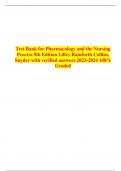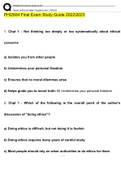Test Bank for Pharmacology and the Nursing
Process 9th Edition Lilley Rainforth Collins,
Snyder with verified answers 2023-2024 100%
Graded
, Table of Content
Chapter 01: The Nursing Process and Drug Therapy .................................................................................... 4
Chapter 02: Pharmacologic Principles .......................................................................................................... 8
Chapter 03: Lifespan Considerations .......................................................................................................... 14
Chapter 04: Cultural, Legal, and Ethical Considerations ............................................................................. 20
Chapter 05: Medication Errors: Preventing and Responding ..................................................................... 26
Chapter 06: Patient Education and Drug Therapy ...................................................................................... 29
Chapter 07: Over-the-Counter Drugs and Herbal and Dietary Supplements ............................................. 34
Chapter 08: Gene Therapy and Pharmacogenomics .................................................................................. 38
Chapter 09: Photo Atlas of Drug Administration ........................................................................................ 41
Chapter 10: Analgesic Drugs ....................................................................................................................... 50
Chapter 11: General and Local Anesthetics ................................................................................................ 57
Chapter 12: Central Nervous System Depressants and Muscle Relaxants ................................................. 61
Chapter 13: Central Nervous System Stimulants and Related Drugs ......................................................... 66
Chapter 14: Antiepileptic Drugs .................................................................................................................. 70
Chapter 15: Antiparkinson Drugs................................................................................................................ 76
Chapter 16: Psychotherapeutic Drugs ........................................................................................................ 81
Chapter 17: Substance Use Disorder .......................................................................................................... 88
Chapter 18: Adrenergic Drugs..................................................................................................................... 93
Chapter 19: Adrenergic-Blocking Drugs ...................................................................................................... 98
Chapter 20: Cholinergic Drugs .................................................................................................................. 103
Chapter 21: Cholinergic-Blocking Drugs ................................................................................................... 108
Chapter 22: Antihypertensive Drugs......................................................................................................... 113
Chapter 23: Antianginal Drugs .................................................................................................................. 119
Chapter 24: Heart Failure Drugs ............................................................................................................... 125
Chapter 25: Antidysrhythmic Drugs .......................................................................................................... 131
Chapter 26: Coagulation Modifier Drugs .................................................................................................. 137
,Chapter 27: Antilipemic Drugs .................................................................................................................. 143
Chapter 28: Diuretic Drugs ....................................................................................................................... 148
Chapter 29: Fluids and Electrolytes .......................................................................................................... 154
Chapter 30: Pituitary Drugs....................................................................................................................... 160
Chapter 31: Thyroid and Antithyroid Drugs.............................................................................................. 163
Chapter 32: Antidiabetic Drugs ................................................................................................................. 168
Chapter 33: Adrenal Drugs........................................................................................................................ 177
Chapter 34: Women’s Health Drugs .......................................................................................................... 181
Chapter 35: Men’s Health Drugs ............................................................................................................... 188
Chapter 36: Antihistamines, Decongestants, Antitussives, and Expectorants ......................................... 193
Chapter 37: Respiratory Drugs .................................................................................................................. 198
Chapter 38: Antibiotics Part 1 ................................................................................................................... 204
Chapter 39: Antibiotics Part 2 ................................................................................................................... 211
Chapter 40: Antiviral Drugs ....................................................................................................................... 216
Chapter 41: Antitubercular Drugs ............................................................................................................. 221
Chapter 42: Antifungal Drugs.................................................................................................................... 226
Chapter 43: Antimalarial, Antiprotozoal, and Anthelmintic Drugs ........................................................... 231
Chapter 44: Anti-inflammatory and Antigout Drugs ................................................................................ 236
Chapter 45: Antineoplastic Drugs Part 1: Cancer Overview and Cell Cycle–Specific Drugs ..................... 242
Chapter 46: Antineoplastic Drugs Part 2: Cell Cycle–Nonspecific Drugs and Miscellaneous Drugs ......... 248
Chapter 47: Biologic Response–Modifying and Antirheumatic Drugs...................................................... 253
Chapter 48: Immunosuppressant Drugs ................................................................................................... 258
Chapter 49: Immunizing Drugs ................................................................................................................. 263
Chapter 50: Acid-Controlling Drugs .......................................................................................................... 268
Chapter 51: Bowel Disorder Drugs ........................................................................................................... 274
Chapter 52: Antiemetic and Antinausea Drugs ........................................................................................ 281
Chapter 53: Vitamins and Minerals .......................................................................................................... 286
Chapter 54: Anemia Drugs ........................................................................................................................ 292
,Chapter 55: Nutritional Supplements ....................................................................................................... 299
Chapter 56: Dermatologic Drugs .............................................................................................................. 304
Chapter 57: Ophthalmic Drugs ................................................................................................................. 310
Chapter 58: Otic Drugs .............................................................................................................................. 315
, Chapter 01: The Nursing Process and Drug Therapy
MULTIPLE CHOICE
1. The nurse is writing a nursing diagnosis for a plan of care for a patient who has been newly
diagnosed with type 2 diabetes. Which statement reflects the correct format for a nursing
diagnosis?
a. Anxiety
b. Anxiety related to new drug therapy
c. Anxiety related to anxious feelings about drug therapy, as evidenced by statements
such as ―I‘m upset about having to test my blood sugars.‖
d. Anxiety related to new drug therapy, as evidenced by statements such as
―I‘m upset about having to test my blood sugars.‖
ANS: D
Formulation of nursing diagnoses is usually a three-step process. ―Anxiety‖ is missing the
―related to‖ and ―as evidenced by‖ portions of defining characteristics. ―Anxiety related to
new drug therapy‖ is missing the ―as evidenced by‖ portion of defining characteristics. The
statement beginning ―Anxiety related to anxious feelings‖ is incorrect because the ―related to‖
section is simply a restatement of the problem ―anxiety,‖ not a separate factor related to the
response.
DIF: COGNITIVE LEVEL: Understanding
(Comprehension) TOP: NURSING PROCESS: Nursing
Diagnosis
MSC: NCLEX: Safe and Effective Care Environment: Management of Care
2. The patient is to receive oral guaifenesin (Mucinex) twice a day. Today, the nurse was busy and
gave the medication 2 hours after the scheduled dose was due. What type of problem does this
represent?
a. ―Right time‖
b. ―Right dose‖
c. ―Right route‖
d. ―Right medication‖
ANS: A
―Right time‖ is correct because the medication was given more than 30 minutes after the
scheduled dose was due. ―Dose‖ is incorrect because the dose is not related to the time the
medication administration is scheduled. ―Route‖ is incorrect because the route is not affected.
―Medication‖ is incorrect because the medication ordered will not change.
DIF: COGNITIVE LEVEL: Applying
(Application) TOP: NURSING PROCESS:
Implementation
MSC: NCLEX: Safe and Effective Care Environment: Safety and Infection Control
,3. The nurse has been monitoring the patient‘s progress on a new drug regimen since the first
dose and documenting the patient‘s therapeutic response to the medication. Which phase of the
nursing process do these actions illustrate?
a. Nursing diagnosis
, b. Planning
c. Implementation
d. Evaluation
ANS: D
Monitoring the patient‘s progress, including the patient‘s response to the medication, is part of
the evaluation phase. Planning, implementation, and nursing diagnosis are not illustrated by
this example.
DIF: COGNITIVE LEVEL: Understanding
(Comprehension) TOP: NURSING PROCESS: Evaluation
MSC: NCLEX: Safe and Effective Care Environment: Management of Care
4. The nurse is assigned to a patient who is newly diagnosed with type 1 diabetes mellitus. Which
statement best illustrates an outcome criterion for this patient?
a. The patient will follow instructions.
b. The patient will not experience complications.
c. The patient will adhere to the new insulin treatment regimen.
d. The patient will demonstrate correct blood glucose testing technique.
ANS: D
―Demonstrating correct blood glucose testing technique‖ is a specific and measurable outcome
criterion. ―Following instructions‖ and ―not experiencing complications‖ are not specific
criteria.
―Adhering to new regimen‖ would be difficult to measure.
DIF: COGNITIVE LEVEL: Applying
(Application) TOP: NURSING PROCESS: Planning
MSC: NCLEX: Safe and Effective Care Environment: Management of Care
5. Which activity best reflects the implementation phase of the nursing process for the patient
who is newly diagnosed with hypertension?
a. Providing education on keeping a journal of blood pressure readings
b. Setting goals and outcome criteria with the patient‘s input
c. Recording a drug history regarding over-the-counter medications used at home
d. Formulating nursing diagnoses regarding deficient knowledge related to the
new treatment regimen
ANS: A
Education is an intervention that occurs during the implementation phase. Setting goals and
outcomes reflects the planning phase. Recording a drug history reflects the assessment
phase. Formulating nursing diagnoses reflects analysis of data as part of planning.
DIF: COGNITIVE LEVEL: Applying
(Application) TOP: NURSING PROCESS:
Implementation
MSC: NCLEX: Safe and Effective Care Environment: Management of Care
,6. The medication order reads, ―Give ondansetron (Zofran) 4 mg, 30 minutes before beginning
chemotherapy to prevent nausea.‖ The nurse notes that the route is missing from the order.
What is the nurse‘s best action?
, a. Give the medication intravenously because the patient might vomit.
b. Give the medication orally because the tablets are available in 4-mg doses.
c. Contact the prescriber to clarify the route of the medication ordered.
d. Hold the medication until the prescriber returns to make rounds.
ANS: C
A complete medication order includes the route of administration. If a medication order does
not include the route, the nurse must ask the prescriber to clarify it. The intravenous and oral
routes are not interchangeable. Holding the medication until the prescriber returns would mean
that the patient would not receive a needed medication.
DIF: COGNITIVE LEVEL: Applying
(Application) TOP: NURSING PROCESS:
Implementation
MSC: NCLEX: Safe and Effective Care Environment: Management of Care
7. When the nurse considers the timing of a drug dose, which factor is appropriate to consider
when deciding when to give a drug?
a. The patient‘s ability to swallow
b. The patient‘s height
c. The patient‘s last meal
d. The patient‘s allergies
ANS: C
The nurse must consider specific pharmacokinetic/pharmacodynamic drug properties that may
be affected by the timing of the last meal. The patient‘s ability to swallow, height, and allergies
are not factors to consider regarding the timing of the drug‘s administration.
DIF: COGNITIVE LEVEL: Understanding
(Comprehension) TOP: NURSING PROCESS: Assessment
MSC: NCLEX: Safe and Effective Care Environment: Management of Care
8. The nurse is performing an assessment of a newly admitted patient. Which is an example of
subjective data?
a. Blood pressure 158/96 mm Hg
b. Weight 255 pounds
c. The patient reports that he uses the herbal product ginkgo.
d. The patient‘s laboratory work includes a complete blood count and urinalysis.
ANS: C
Subjective data include information shared through the spoken word by any reliable source, such
as the patient. Objective data may be defined as any information gathered through the senses or
that which is seen, heard, felt, or smelled. A patient‘s blood pressure, weight, and laboratory
tests are all examples of objective data.
DIF: COGNITIVE LEVEL: Understanding
(Comprehension) TOP: NURSING PROCESS: Assessment
MSC: NCLEX: Safe and Effective Care Environment: Management of Care
, MULTIPLE RESPONSE





